***
Baltics trip
Day 14 - 29th May - Tallinn, Estonia (Part 3)
I saw a girl in a kiddy outfit holding a giant pacifier. The guy beside her held a giant toy mouse. Perhaps this was the Tallinn chapter of the group from the previous day.

"This is your brain on alcohol"

Old Tallinn map on wall

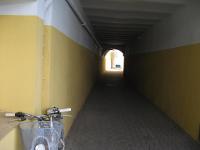
Tunnel
I then hiked up the town hall tower.

Neat tower features: at 77m there was a toilet hole for the tower guard, a quick-pull mechanism for someone at the tower's base to ring the bells and part of the staircase could be destroyed for easy defence.

Loo hole

Removable wooden flooring

Quick pull mechanism

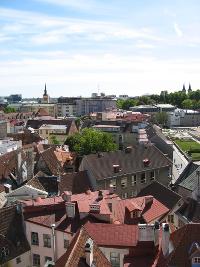



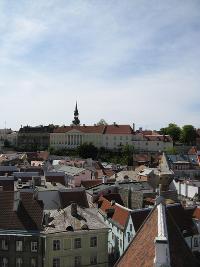

View from top of tower

Square from tower top

Bell


Me. I couldn't get the background to show up properly.
I considered hiking up St Olaf's also but my knees probably wouldn't take kindly to more than 1 hike a day, so.
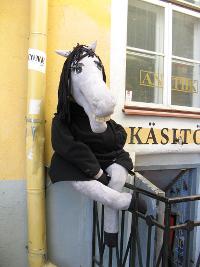
Coquettish horse

"Voorimehe (Coachman) street is one of the oldest streets... Obviously it got such a name after a bunch of horsemen, who used to stand besides the horse-drowns on the Time Hall square."

Voorimehe (Coachman) street
I then proceeded to the Estonian History Museum housed in the Great Guild building.

Great Guild plaque. Liszt also performed here.

Museum entrance. Note what look to be removed ettic stones.

Upper part of museum building

Door knocker on entrance
The museum was great. Even the toilet was interesting:

Toilet wall tile with cute dragon
Once again, they were very honest about history, with a section dedicated to historiography. What a self-aware country!:

"Every era views its’s past from a different angle, emphasizing things that later generations might find odd, uncomprehensible, repelling or just plain wrong.
In the early 19th century, the artist Ludwig von Maydell was convinced, that the history of the Baltic nations did not begin until the arrival of the first German merchant. His attitude is well-reflected by his depictions of ancient Livonians, Latgallians and Estonians as half-crazed savages.
After the creation of the independent Estonian state, the view on the same events became exactly the opposite. The prehistoric times were considered to be Estonians “own” history, as opposed to the Middle and Modern Ages spent under foreign rule.
Under the Soviet occupation the emphasis moved to the relations of the ancient Estonians and Russians — it was postulated, that the ,,historical destiny” of the Estonians has always been to remain in the Russia’s sphere of influence.
Now, when Estonia has regained it’s independence and entered the community of the European nations, the political situation has changed again and we are creating another version of those crucial events of the Estonian history."
They even provided extracts from different historical sources to illustrate this point:

"Regardless of the fact that this land was populated long before the Western colonization, we find it lacking any true history until then, because the history gives no notice to the aimless wanderings of the hordes of barbarians" - Foreword to Ludwig von Maydell's album of prints "Fifty Scenes from the History of the German Baltic Provinces of Russia", 1839

"The Ancient Struggle for Freedom, ending with defeat for our nation was a political catastrophe, which has left a major imprint to our history. The prospects of development in all facets of life of our nation were cut off and smothered...
History of Estonia I, 1935"
"But fifteen years of war had left the land devastated and the men few. It was clear that alone there will be no hope to resist the crusaders. For that the elected elders of the people were sent with pleas of help to Pskov and Novorod, where the Russians gave them horses and weapons and treated them like brethren. The Russians were glad to extend a helping hand.
From the historical novel "Meelis" by E.Kippel, 1941."

The Burning Crusade:
"The crusaders attacked peaceful villages, murdering and burning until the knights and their horses collapsed from exhaustion... The Estonions who escaped the massacres, were forced to accept Christianity. So was Estonia baptized - by sword and fire.
“Stories from the Past of our Homeland” History schoolbook for the 4th grade, 1978"
The above was interesting because, as in one other place I'd been to (Greece?!), they were obviously pissed off at being converted by the sword, yet to denounce their conversion too loudly would be to repudiate their current religion (which they were committed to the truth of).
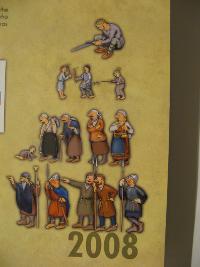
Looking back on the past

Globalisation: the Greek
Some Princes and other political leaders put off conversion to Christianity because marriage would lead to a lasting alliance. It took only 50 years to convert Hungary, Poland, Denmark and Sweden.
There was also a sandbox for kids to pretend to be archaeologists:

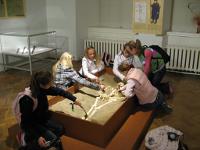

A great bedtime story:

"The baptisms performed in Estonia during the years 1208-1227 by Germans and Danes
were primarily a ritual symbolizing the subjugation and submission of Estonians. A
chieftain from Northern-Estonian county of Virumaa, Tabelinus, was baptized by Germans on three different occasions and as his lands were situated in the disputed area, Tabelinus was later executed by Danes for accepting the “wrong” German baptism. As a counter-ritual of defiance, the Estonians used to "wash off" their baptisms with plain water as a sign of breaking off from the Christian rule."


Battle axes

Spear heads

Swords



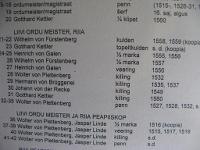



Lots of coins

Map of Estonia, 1774, with Double-Headed Eagle

Siege scene

The Late Iron Age (11th-13th century) i.e. forced conversion

Caltrops

Crusader kit
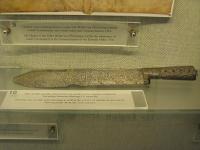
Hunting knife, 16th c.